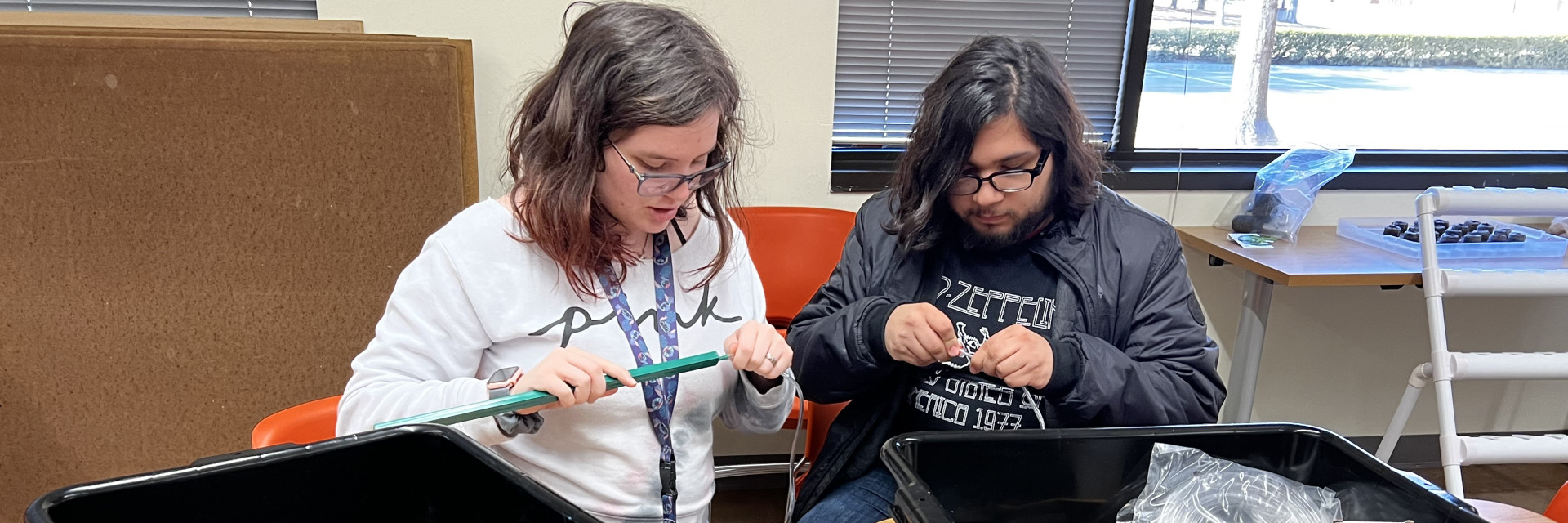
Ready for Liftoff: Toyota Partnership Fuels Space Learning for Rising for Plano Academy
Young people are often encouraged to dream big, set ambitious goals, and “reach for the stars.” But at Plano ISD Academy High School—an innovative campus just north of Dallas, Texas—a group of enthusiastic young learners is turning that cliché into reality.
The Academy is participating in the Student Spaceflight Experiments Program (SSEP), an initiative in which students from 5th grade through college can design and propose real microgravity experiments to be conducted by astronauts at the International Space Station. SSEP allows young people to step into the shoes of scientists (by engaging in hands-on learning that builds skills in research, ideation, and problem-solving, among others) and potentially see their work go into orbit.
“It’s an incredible opportunity for our learners. Not many high school students get the chance to send a science experiment that they have designed into space. It fits with the Academy’s unique approach, which is about helping young people grow and develop through real-world experiences, project-based learning, and collaboration,” explains principal Catherine Gaschen.
Indeed, the Academy is not your average high school. It’s a multidisciplinary learning community with a focus on science, technology, engineering, arts and math (STEAM). At its state-of-the-art campus, students are called “learners,” teachers are “facilitators,” classrooms are “learning spaces,” and there are no defined class periods. Open to interested students entering 9th grade through a lottery enrollment process, the school welcomes learners of all backgrounds and abilities.
The Academy’s cutting-edge approach has also helped seed and nurture a successful collaboration with Toyota that is now a decade old.
Prior to opening the Plano headquarters, Toyota kicked off community engagement in North Texas in 2014 with a $1 million contribution to the Academy. The gift was a way to recognize the importance of having top-notch, 21st-century educational institutions that prepare local youth to thrive in the careers of the future—and it was only the beginning. Toyota then teamed up with the Academy to establish a 12-week mentoring program that equips learners with Toyota business practices and problem-solving skills. Toyota team members have also taught Toyota project management skills to Academy facilitators.
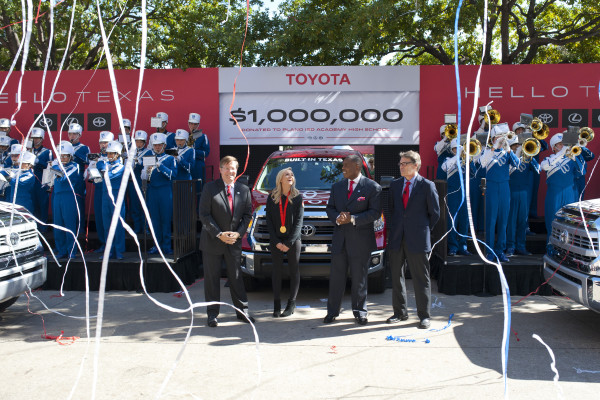
Toyota North America former CEO Jim Lentz (left to right), Olympic gold medalist Nastia Liukin, former Plano Mayor Harry LaRosiliere and former Texas Governor Rick Perry announce a $1,000,000 donation from Toyota to the Plano ISD Academy High School during the Toyota "Hello Texas" event on Oct. 27, 2014 in Plano, Texas. Photo: Cooper Neill/Getty Images for Toyota
Toyota Sustainable Development team member Karlynda Brazeal has worked with the Academy for almost two years and enjoyed opportunities for deep engagement with leaners and facilitators. In her experience, “The Academy is a special place that is reimagining education as we know it. It’s a proven model that engages young people and creates space for every type of learner.”
Part of Toyota’s initial $1 million gift is being used to support the Academy’s participation in SSEP. Principal Gaschen says, “It’s a great example of how our collaboration with Toyota is multifaceted and gives us the ability to be even more innovative. And for a high school science project to end up at the space station—that really takes the idea of mobility to a whole new level!”
Open to Academy learners in grades 9 through 12, SSEP sparked interest from nine teams, each made up of two or three individuals. The teams spent several months creating detailed proposals for original microgravity experiments that could fly to the International Space Station as part of SSEP Mission 18 in 2024. The Academy chose three proposals, all developed by teams of seniors, to be sent to Washington, D.C., for evaluation by the SSEP National Step 2 Review Board.
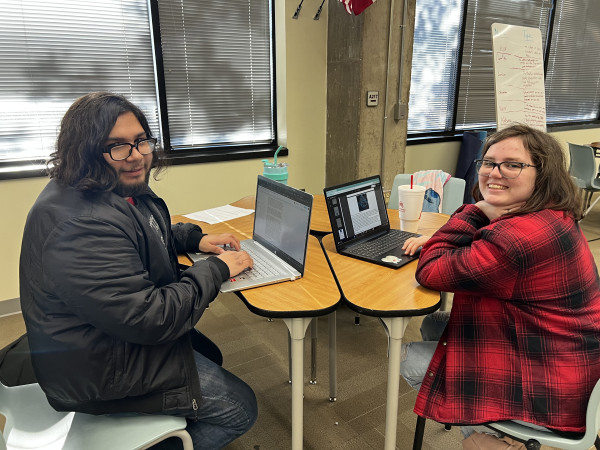
Efrain and Becca (left to right) preparing their SSEP proposal.
Among the eight seniors, there’s a remarkable diversity of academic and professional interests, from space-related fields like astronomy and aerospace engineering all the way to adjacent or less directly related areas like biology and law. But no matter their aspirations, each learner says the project has taught them important and relevant lessons that they’ll take with them on their career and life journeys. Things like how to realistically scope a research project given constraints and abilities; how to pivot when things go wrong; and even how to write a proposal.
And for each senior, there’s the undeniable truth that space is just really cool.
“The space factor was one of the reasons I wanted to do the project. It was awesome, especially after we did our first slide show and presented our research idea to the other teams. Justine and I high-fived each other because it was really cool!” says Savannah, who together with teammate Justine proposed a seed germination experiment to see how kale and spinach plants might fare in microgravity.
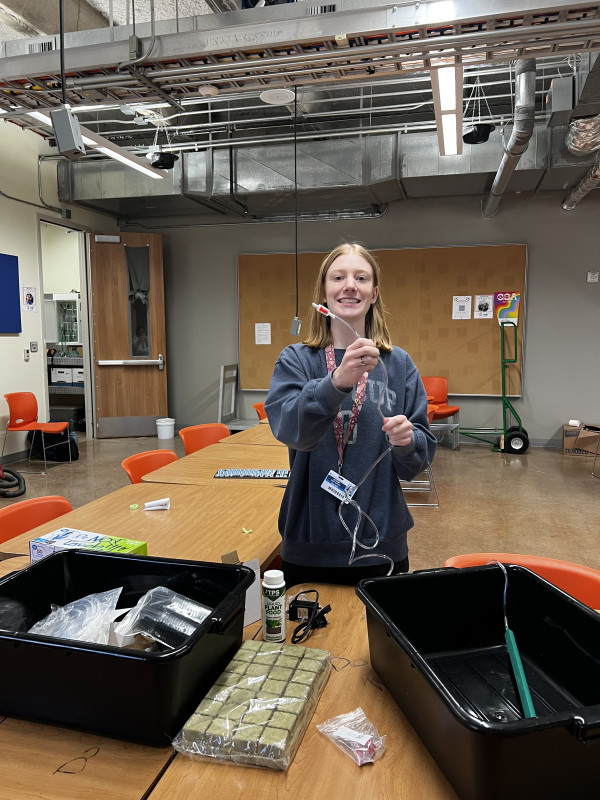
Anna assembles the hydroponics system for her SSEP team project. She is attaching a water valve to the tubing for the circulation of water through the system.
Seniors Abhi, Jacob, and Nawal were just as excited about their proposal, which involves raising crickets at the space station to determine how the microgravity environment might impact their bodily makeup, specifically their protein content. As Abhi explains, “Crickets have a higher protein content compared to other meats and are much more efficient to farm, which makes them pretty beneficial for human consumption in general, and for astronauts specifically.” Scientific Research and Design facilitator Mary Imran, who advised all of the project teams, admits to having some “squeamish moments” with “Team Cricket”.
The third senior team also proposed a plant-related project, but with an extra twist. “Our experiment is growing plants with an added bacteria called methylobacterium that’s known for increasing plant growth on Earth. We want to know if the bacteria has the same effects in space,” says 12th grader Anna, who collaborated with teammates Becca and Ephrain.
Whether or not their proposed experiment actually makes it into space, just knowing that it could has affected the way many of the seniors have approached and thought about the project. “I like to think of it not as a maybe, or if it goes to space, but that this is going to be sent to space. Even if it ends up not going, I can still think of it as going, which has really changed my thinking. And if it goes well, I’m helping humanity,” says Ephrain.
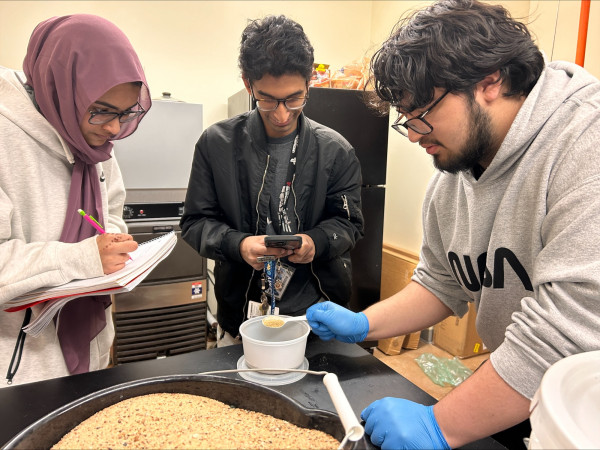
Nawal (left to right), Abhi, and Jacob measure feed for the crickets they are farming. They need to harvest the eggs for their project- to see the impact of the lack of gravity on a cricket’s growth.
In late 2023, the Academy got some out-of-this-world news. Team Cricket’s proposal will advance to the final selection round, bringing their experiment one step closer to space!
Team member Jacob, who is considering aerospace engineering as a potential career path, is over the moon about making it to the finals. “I’m a huge fan of space exploration, and it’s so cool to know our project might have a chance to help further human spaceflight.”
As our first decade of collaboration with Plano Academy draws to a close, Toyota is immensely proud of the dynamic, multi-faceted ways we have worked together to support the dreams and aspirations of Academy learners. Their remarkable achievements show what’s possible when young people have the educational tools and experiences they need to reach for the stars and embrace Limitless Possibilities.
The Student Spaceflight Experiments Program (SSEP) is a program of the National Center for Earth and Space Science Education (NCESSE) in the U.S. and the Arthur C. Clarke Institute for Space Education internationally. It is enabled through a strategic partnership with Nanoracks, LLC, which is working with NASA under a Space Act Agreement as part of the utilization of the International Space Station as a National Laboratory.
